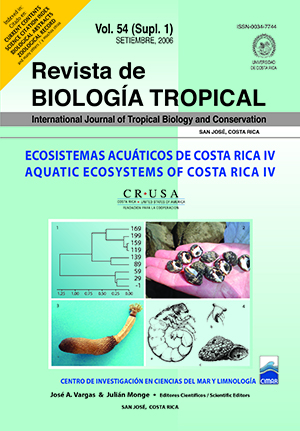Abstract
Specimens of the sipunculans Phascolosoma perlucens, Antillesoma antillarum, and Sipunculus nudus, were collected for PCB analysis in three coastal embayments on the Pacific coast of Costa Rica in October 2005. After collection the worms were kept in cool sea water and transferred to the laboratory for freeze drying. Half of the specimens of S. nudus were depurated in filtered sea water for 72 h before freeze drying. The whole worm sample was ground, using a mortar and pestle prior to being extracted with dichloromethane solvent. The extract was cleaned using a florisil column and analyzed using a 6890 Hewlett-Packard gas chromatograph equipped with a mass selective detector. Recovery efficiencies averaged between 72 and 80 %. Data are not corrected for blank or recovery efficiencies. Concentration data were calculated based on comparison with standards for Arochlor 1221, 1242, 1248 and 1254 (Supelco, Inc. ®). No worm samples were identified with six or more chlorine atoms. However, the higher chlorinated congeners were identified in the standards. Therefore, the lack of chlorination in the worms was not an analytical artifact. The sum of identifiable PCBs ranged from a barely discernable 0.01 ng/g dry wt in an A. antillarum sample from Culebra Bay to 67.71 ng/g dry wt in a P. perlucens sample obtained near the Rincón river in the inner Golfo Dulce. S. nudus worm samples from the Cocorocas sand flat in the Gulf of Nicoya had relatively high concentrations of PCBs whether they were depurated or not. The samples from Costa Rica are low in PCBs, especially compared to the marine sediment samples measured previously in Costa Rica. This was the first attempt to identify and quantify the presence of PCBs in any marine organisms from the Pacific coast of Costa Rica. Rev. Biol. Trop. 54 (Suppl. 1): 27-33. Epub 2006 Sept. 30.References
Bednarski, M. & A. Morales-Ramírez. 2004. Composition, abundance and distribution of macrozooplancton in Culebra Bay, Gulf of Papagayo, Pacific coast of Costa Rica, an its value as bioindicator of poblation. Rev. Biol. Trop. 52 (Suppl. 2): 105-118.
Cutler, N.J., E. Cutler & J. A. Vargas. 1990. Peanut worms (Phylum Sipuncula) from Costa Rica. Rev. Biol. Trop. 40: 153-158.
Cutler, E.B. 1994. The Sipuncula. Their systematics, biology, and evolution. Cornell University, Ithaca, New York, New York, USA.
Dalsgaard, T., D.E. Canfield, J. Peterson, B. Thamdrup & J. Acuña-González. 2003. N2 production by the anammox reaction in the anoxic water column of Golfo Dulce, Costa Rica. Nature 422: 606-608.
Dean, H.K. 2001. Marine biodiversity of Costa Rica. The phyla Sipuncula and Echiura. Rev. Biol. Trop. 49 (Suppl. 2): 85-90.
Dittmann, S. & J. A. Vargas. 2001. Tropical tidal flat benthos compared between Australia and Central America. In K. Reise (ed.). Ecological Comparisons of Sedimentary Shores. Ecol. Stud. 151: 275- 293.
Jager, T., H.L. Roel, J. Fleuren, E.A. Hogendoorn & G. de Korte. 2003. Elucidating the Routes of Exposure for Organic Chemicals in the Earthworm Eisenia endrei (Oligochaeta). Env. Sci. Techno. 37: 3399-3404.
Maurer, D. & J.A. Vargas. 1984. Diversit of soft-bottom benthos in a tropical estuary: Gulf of Nicoya, Costa Rica. Mar. Biol. 81: 97-106.
Oberdörster, E. & A.O. Cheek. 2000. Gender benders at the beach: endocrine disruption in marin and estuarine organisms. Environ. Toxicol. Chem. 20: 23-26.
Ruppert, E. E. & M. E. Rice. 1995. Functional organization of dermal coelomic canals in Sipunculus nudus (Sipuncula) with a discussion of respiratory designs in sipunculans. Invert. Biol. 114: 51-63.
Spongberg, A.L. 2004a. PCB concentrations in surface sediments in the coastal waters of Costa Rica. Rev. Biol. Trop. 52 (Suppl.2): 1-10.
Spongberg, A.L. 2004b. PCB concentrations in sediments from the Gulf of Nicoya estuary, Pacific coast of Costa Rica. Rev. Biol. Trop. 52 (Suppl. 2): 11-22.
Spongberg, A.L. 2004c. PCB concentrations in marine sediments from Golfo Dulce, Pacific coast of Costa Rica. Rev. Biol. Trop. 52 (Suppl. 2): 23-32.
VanderPol, S.S., P.R. Becker, J.R. Kucklick, R.S. Pugh, D. G. Roseneau & K.S. Simac. 2004. Persistent Organic Pollutants in Alaskan Murre (Uria spp.) Eggs: Geographical, Species and Temporal Comparison. Env. Sci. Techno. 38: 1305-1312.
Wong, C. S., S.A. Mabury, D. M. Whittle, S. M. Backus, C. Teixeira, D. S. Devault, D.R. Bronte & D.C.G. Muir. 2004. Organochlorine compounds in Lake Superior: polychlorinated biphenyls and biotransformation in the Aquatic Food Web. Env. Sci. Techno. 38: 84-92.
Federal Register. 2004. Historic Area Remediation Site (HARS) – Specific Polychlorinated Biphenyl Worm Tissue Criterion, 40 CFR Part 228. Vol 68 (51). (Downloaded July 30, 2006; wais.access.gpo.gov).
##plugins.facebook.comentarios##

This work is licensed under a Creative Commons Attribution 4.0 International License.
Copyright (c) 2006 Revista de Biología Tropical






